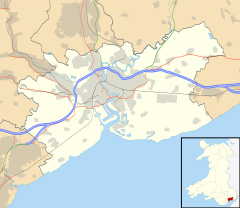Our website is made possible by displaying online advertisements to our visitors.
Please consider supporting us by disabling your ad blocker.
Caerleon
Caerleon
| |
|---|---|
 Caerleon from St Julians | |
Location within Newport | |
| Area | 9.03 sq mi (23.4 km2) [1] |
| Population | 8,061 [2][full citation needed] |
| • Density | 893/sq mi (345/km2) [3] |
| Demonym | Caerleonite |
| OS grid reference | ST336909 |
| • Cardiff | 13 mi (21 km) westwards |
| • London | 122 mi (196 km) eastwards |
| Community | |
| Principal area | |
| Preserved county | |
| Country | Wales |
| Sovereign state | United Kingdom |
| Post town | NEWPORT |
| Postcode district | NP18 |
| Dialling code | 01633 |
| Police | Gwent |
| Fire | South Wales |
| Ambulance | Welsh |
| UK Parliament | |
| Senedd Cymru – Welsh Parliament | |
| Website | council website |
Caerleon (/kərˈliːən/ kər-LEE-ən; Welsh: Caerllion) is a town and community in Newport, Wales. Situated on the River Usk,[4][5] it lies 5 miles (8 km) northeast of Newport city centre, and 5.5 miles (9 km) southeast of Cwmbran. Caerleon is of archaeological importance, being the site of a notable Roman legionary fortress, Isca Augusta, and an Iron Age hillfort. Close to the remains of Isca Augusta are the National Roman Legion Museum and the Roman Baths Museum. The town also has strong historical and literary associations: Geoffrey of Monmouth elevated the significance of Caerleon as a major centre of British history in his Historia Regum Britanniae (c. 1136), and Alfred Lord Tennyson wrote Idylls of the King (1859–1885) while staying in Caerleon.
- ^ "Caerleon Profile" (PDF) (final ed.). 2017.
- ^ Census, 2011
- ^ List of Welsh principal areas by population density
- ^ "Caerleon – Newport City Council". www.newport.gov.uk. Retrieved 31 October 2017.
- ^ "The River Usk, looking downstream". Geograph (geograph.org.uk). Retrieved 15 December 2016.
(c) Roger Cornfoot
Previous Page Next Page




